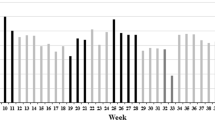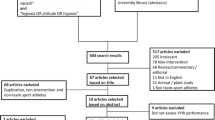Abstract
Introduction
High altitude training has become a mainstay in endurance sports, with live high–train low as the current protocol of choice. Athletes either live or sleep in artificial or natural hypoxic conditions with the aim to increase serum erythropoietin concentrations, which are thought to improve maximum oxygen uptake and thus exercise performance.
Discussion
Changes, however, are not very striking and only apparent in so-called responders, who are not a well-defined group and may be as little as 50% of the trained study population. Whereas some studies show minor improvement, others report no change or even worsening. Furthermore, the mechanisms behind the proposed beneficial changes remain obscure and are far from being proven. There is an evident lack of sufficiently powered randomized, double-blinded studies, with training protocols that are identical for all groups and groups that are indeed comparable. Several studies discriminate between responders and non-responders, without clearly assessing the characteristics of the so-called responders. Until this has been done, it remains unclear if such a group really exists and how these subjects are characterized. This, however, would be of immense value, so protocols could be tailored to athletes’ needs. Taken together, the current literature on natural or artificial hypoxia somewhat documents improved performance at high but not low altitude.
Similar content being viewed by others
References
Ashenden MJ, Gore CJ, Dobson GP, Hahn AG (1999) “Live high, train low” does not change the total haemoglobin mass of male endurance athletes sleeping at a simulated altitude of 3000 m for 23 nights. Eur J Appl Physiol Occup Physiol 80:479–484
Ashenden MJ, Gore CJ, Martin DT, Dobson GP, Hahn AG (1999) Effects of a 12-day “live high, train low” camp on reticulocyte production and haemoglobin mass in elite female road cyclists. Eur J Appl Physiol Occup Physiol 80:472–478
Burtscher M, Haider T, Domej W, Linser T, Gatterer H, Faulhaber M, Pocecco E, Ehrenburg I, Tkatchuk E, Koch R, Bernardi L (2009) Intermittent hypoxia increases exercise tolerance in patients at risk for or with mild COPD. Respir Physiol Neurobiol 165:97–103
Dehnert C, Hutler M, Liu Y, Menold E, Netzer C, Schick R, Kubanek B, Lehmann M, Böning D, Steinacker JM (2002) Erythropoiesis and performance after two weeks of living high and training low in well trained triathletes. Int J Sports Med 23:561–566
Dufour SP, Ponsot E, Zoll J, Doutreleau S, Lonsdorfer-Wolf E, Geny B, Lampert E, Flück M, Hoppeler H, Billat V, Mettauer B, Richard R, Lonsdorfer J (2006) Exercise training in normobaric hypoxia in endurance runners. I. Improvement in aerobic performance capacity. J Appl Physiol 100:1238–1248
Eckardt KU, Boutellier U, Kurtz A, Schopen M, Koller EA, Bauer C (1989) Rate of erythropoietin formation in humans in response to acute hypobaric hypoxia. J Appl Physiol 66:1785–1788
Gore CJ, Clark SA, Saunders PU (2007) Nonhematological mechanisms of improved sea-level performance after hypoxic exposure. Med Sci Sports Exerc 39:1600–1609
Gore CJ, Hahn AG, Aughey RJ, Martin DT, Ashenden MJ, Clark SA, Garnham AP, Roberts AD, Slater GJ, McKenna MJ (2001) Live high: train low increases muscle buffer capacity and submaximal cycling efficiency. Acta Physiol Scand 173:275–286
Gore CJ, Hopkins WG (2005) Counterpoint: positive effects of intermittent hypoxia (live high:train low) on exercise performance are not mediated primarily by augmented red cell volume. J Appl Physiol 99:2055–2057, discussion 2057–2058
Gore CJ, Rodríguez FA, Truijens MJ, Townsend NE, Stray-Gundersen J, Levine BD (2006) Increased serum erythropoietin but not red cell production after 4 wk of intermittent hypobaric hypoxia. (4,000–5,500 m). J Appl Physiol 101:1386–1393
Hahn AG, Gore CJ (2001) The effect of altitude on cycling performance: a challenge to traditional concepts. Sports Med 31:533–557
Hahn AG, Gore CJ, Martin DT, Ashenden MJ, Roberts AD, Logan PA (2001) An evaluation of the concept of living at moderate altitude and training at sea level. Comp Biochem Physiol A 128:777–789
Hamlin MJ, Hellemans J (2007) Effect of intermittent normobaric hypoxic exposure at rest on haematological, physiological, and performance parameters in multi-sport athletes. J Sport Sci 25(4):431–441
Hinckson EA, Hopkins WG, Edwards JS, Pfitzinger P, Hellemans J (2005) Sea-level performance in runners using altitude tents: a field study. J Sci Med Sport 8:451–457
Huang LE, Gu J, Schau M, Bunn HF (1998) Regulation of hypoxia-inducible factor 1alpha is mediated by an O2-dependent degradation domain via the ubiquitin–proteasome pathway. Proc Natl Acad Sci USA 95:7987–7992
Julian CG, Gore CJ, Wilber RL, Daniels JT, Fredericson M, Stray-Gundersen J, Hahn AG, Parisotto R, Levine BD (2004) Intermittent normobaric hypoxia does not alter performance or erythropoietic markers in highly trained distance runners. J Appl Physiol 96:1800–1807
Katayama K, Matsuo H, Ishida K, Mori S, Miyamura M (2003) Intermittent hypoxia improves endurance performance and submaximal exercise efficiency. High Alt Med Biol 4:291–304
Katayama K, Sato K, Matsuo H, Ishida K, Iwasaki K, Miyamura M (2004) Effect of intermittent hypoxia on oxygen uptake during submaximal exercise in endurance athletes. Eur J Appl Physiol 92:75–83
Levine BD, Stray-Gundersen J (1997) “Living high-training low”: effect of moderate-altitude acclimatization with low-altitude training on performance. J Appl Physiol 83(1):102–112
Levine BD, Stray-Gundersen J (2005) Point:counterpoint: positive effects of intermittent hypoxia (live high:train low) on exercise are/are not mediated primarily by augmented red cell volume. J Appl Physiol 99:2053–2055
Lundby C, Calbet JAL, Sander M, van Hall G, Mazzeo RS, Stray-Gundersen J, Stager JM, Chapman RF, Saltin B, Levine BD (2007) Exercise economy does not change after acclimatization to moderate to very high altitude. Scand J Med Sci Sport 17:281–291
Ponsot E, Dufour SP, Zoll J, Doutrelau S, N'Guessan B, Geny B, Hoppeler H, Lampert E, Mettauer B, Ventura-Clapier R, Richard R (2006) Exercise training in normobaric hypoxia in endurance runners. II. Improvement of mitochondrial properties in skeletal muscle. J Appl Physiol 100:1249–1257
Reynafarje C, Lozano R, Valdivieso J (1959) The polycythemia of high altitudes: iron metabolism and related aspects. Blood 14:433–455
Rodriguez FA, Ventura JL, Casas M, Casas H, Pagés T, Rama R, Ricart A, Palacios L, Viscor G (2000) Erythropoietin acute reaction and hematological adaptations to short, intermittent hypobaric hypoxia. Eur J Appl Physiol Occup Physiol 82:170–177
Saltin B (1996) Exercise and the environment: focus on altitude. Res Q Exerc Sport 67:S1–S10
Sasaki R, Masuda S, Nagao M (2000) Erythropoietin: multiple physiological functions and regulation of biosynthesis. Biosci Biotechnol Biochem 64:1775–1793
Saunders PU, Telford RD, Pyne DB, Cunningham RB, Gore CJ, Hahn AG, Hawley JA (2004) Improved running economy in elite runners after 20 days of moderate simulated altitude exposure. J Appl Physiol 96:931–937
Terrados N, Melichna J, Sylven C, Jansson E, Kaijser L (1988) Effects of training at simulated altitude on performance and muscle metabolic capacity in competitive road cyclists. Eur J Appl Physiol Occup Physiol 57:203–209
Vallier JM, Chateau P, Guezennec CY (1996) Effects of physical training in a hypobaric chamber on the physical performance of competitive triathletes. Eur J Appl Physiol Occup Physiol 73:471–478
Wehrlin JP, Zuerst P, Hallén P, Marti B (2006) Live high-train low for 24 days increases hemoglobin mass and red cell volume in elite endurance athletes. J Appl Physiol 100:1938–1945
Wallechinsky D (2004) The complete book of the Summer Olympics, Athens 2004th edn. Sport Media, Toronto
Wilber RL (2001) Current trends in altitude training. Sports Med 31:249–265
Author information
Authors and Affiliations
Corresponding author
Rights and permissions
About this article
Cite this article
de Paula, P., Niebauer, J. Effects of high altitude training on exercise capacity: fact or myth. Sleep Breath 16, 233–239 (2012). https://doi.org/10.1007/s11325-010-0445-1
Received:
Revised:
Accepted:
Published:
Issue Date:
DOI: https://doi.org/10.1007/s11325-010-0445-1




